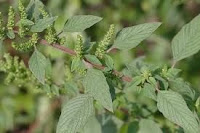The table below comprises some of the most popular indigenous weeds. They are also indicators of the type and quality of the soil when they are wildy growing.
| Name of the plant | Photo | What do they show? | Observations |
| Field Bindweed (Convolvus arvensis) | Heavy clay soil, rich in Nitrogen | Avoid using the rotary tiller because it multiplies the fragments of the rhizomes which root very quickly. | |
| Lawn Daisy (Bellis perennis) | Clay soil with an acidic tendency | This plant is not at all competing with the others. | |
| Smooth Pigweed (Amaranthus hybridus) | Soil rich in Nitrogen | The plant produces many seeds and becomes quickly invasive. | |
| Common Broom (Cytisus scoparius) | Acid soil, often sandy | Usually good soils for strawberries and asparagus. | |
| Common Dandelion (taraxacum officinale) | Heavy clay soil, rather compact, rich in organic matter. | While it is not competing with other plants, it still needs to be removed completely from the ground. | |
| Couch grass (Elytrigia spp) | Exhausted soil, too mechanically cultivated, too rich in potassium and nitrogen | Avoid using the rotary tiller because each fragment produces a new plant. | |
| Common purslane (Portulaca oleracea) | Sandy soil which does not retain water, showing first signs of erosion | Rather a Southern type of plant which can be consumed fresh or prepared. Rich in vitamins. | |
| Common Horsetail (Equisetum arvensis) | Wet soil, insufficinetly aerated | Horsetail indicates that a high flow of water. | |
| Wild carrot (Daucus carota) | Lime dry soil | Do not remove all the plants because it is a host for various useful butterflies and insects. | |
| Flanders poppy (Papaver rhoeas) | Humus rich soil | Indicates a good agricultural soil. |
















0 comments:
Post a Comment